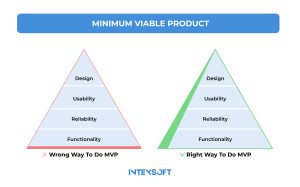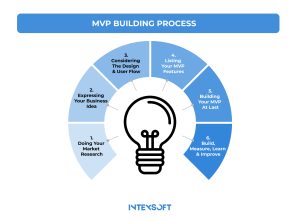How to Build an MVP for Food Delivery App Development: A Step-by-Step Guide

Learn how to create a minimum viable product (MVP) for a food delivery app with our food delivery app development tutorial. Discover the essential steps and strategies to launch your app successfully and attract users.
Reading time: 16 min.
The food takeout industry that has grabbed deserved attention from many is currently growing at a rapid pace, with people consuming quick tastes of their favorites, for which delivery apps are eternally the existing sources to rely upon. However, if you need a complete takeaway service from scratch, it would take years to create that-in addition to the huge stress imposed by the hikes in investment. In order to reduce risks and validate the idea of the business, building a Minimum Viable Product (MVP) seems a better option.
Getting an MVP put out there helps you get real user feedback, refine your viable product, and eventually roll it out to a larger audience with some cheap basic attributes. Allowing for the swift and lean food delivery mobile app development with fewer expenses would proportionately increase the odds of success for any old business. In this article, we list all major features that would vest in project-building for an app.
In a fiercely competitive and fast-paced food delivery industry, it really helps to start with a Minimum Viable Product (MVP); this scenario fits as pragmatically as it could for both startups and established corporations. Real food delivery applications creators get a chance to test the main concept and possibly save cost to develop a food delivery app of real-world user feedback before scaling the product. MVP development just happens to be the best way to go about designing food delivery software.
Building an MVP of an online food delivery marketplace is the right approach to pilot a conceptual business model before going to full-scale development. This MVP is all about a few essential functions that need to solve the most earnest problems of the target consumer. On this very step-by-step guide, we begin with the full grasp of your core pain, followed by commiserating on minimizing agreements on what features are necessary in your MVP.
Before you delve into the development of the technological aspects of your MVP, it starts with having a fantastic understanding of your basic problem which you are attempting to solve by stating, in essence, a hypothesis about what your target market demands and testing just to check if there is actual demand.
Begin by identifying the primary pain points of your customers: imagine, if you are an online food delivery marketplace, that these could be something boring, like:
Once these issues have been acknowledged, you can solve them for added customer satisfaction.
In any startup, assumptions are inevitable. However, some of these assumptions carry more risk than others. For example:
Spot the most risky assumptions in the business plan. It could be connected with the customers’ interest or accessibility of types of restaurants, aggregations, or transportation solutions. Understanding and turning these risks around from the ground up is critical for the success of any MVP.
The next order after formulating your hypothesis is to test it out. Before going all out on development, test your assumptions by collecting feedback from potential clients and restaurateurs. You could arrange surveys, interviews, or even focus groups to learn about the expectations of users and validate your whole idea. If all assumptions turn out false, then a correct pivot at an early stage will save time and money.
While building an MVP, focus on the core features that are related to solving the customers’ most immediate pain-points. In a state-of-the-art application, housed within the simplest possible frame, develop an MVP that only touches the essentials. This simple MVP design paves the way for any new versions and improvements to follow.
Here are the core features you should prioritize for the MVP of your food delivery marketplace:

These features are the absolute basics for your MVP to create a foundation to start with. They are sufficient to be able to launch your marketplace and get the first round of feedback from real-world users.
Not all features should be included in the MVP stage; since adding too many complicated ones will unnecessarily delay the launch, increase costs, and confuse the application. The following is a list of features that should be excluded from the MVP level:
To build an MVP for an online food delivery marketplace, it is important to focus on the core features that deal with the essential pain points faced by prospective customers. By first defining the core issue and then by testing your assumptions, you would be able to ensure that your MVP is based on the real needs of the customers.

By the MVP exercise, one can get feedback from users, enabling you to make informed decisions about which feature should come next, ensuring the successful continuation of the food delivery marketplace.
IntexSoft is not only engaged in on demand food delivery app development, we also want to present our enterprise solution. IntexSoft Food is a web application that automates and simplifies the process of ordering and delivering food to the company’s offices.
The idea to develop a food delivery app for our employees is based on the belief that for truly high-quality results, it is necessary to do more than ensure our employees have decent working conditions. In fact, it’s essential that they feel relaxed as well, especially when it comes to easy access to a nourishing lunch.
Every day, all employees of the company can place an order using the application. The food delivery establishment sets a daily deadline, after which orders are not accepted. After the deadline, a table with orders is formed.
In addition, the application has functionality aimed at user convenience:
When customized food delivery app development the IntexSoft Food application, the team adopted a Minimum Viable Product (MVP) approach to ensure a fast and cost-effective launch. By focusing on the essential features that would immediately address user needs, the team was able to build a functional, easy-to-use platform without the overhead of unnecessary complexity. The MVP development process prioritized the core functionality required to automate and simplify the process of ordering and delivering food within company offices.
The main objective of the MVP was to solve employee lunchtime challenges by providing a simple way to order food, track delivery, and enjoy a stress-free break. Key features of the MVP IntexSoft Food include the following:
The development of IntexSoft Food relied on modern technologies to ensure scalability and performance. The app was built using:
These technologies were carefully chosen to ensure that the MVP could handle the expected user load, with room for future expansion as the application grew and more features were added.
With the MVP in place, IntexSoft Food was launched with a focus on testing real user needs and gathering feedback. The MVP approach allowed the team to quickly assess whether employees found value in the service and which aspects of the platform needed refinement. IntexSoft could efficiently address the fundamental issues surrounding session scope cart and associated problems without the risk of overcomplicating their first effort.
User reviews provided a general idea of where to undertake updates, which included meal customization along with payment notification and delivery settings. This iterative approach enabled IntexSoft Food to grow organically, allowing the team to prioritize features that would make the most significant impact on users.
This MVP stage of the development of the project allows for good insights into real market needs that support a flexible pattern of development stemming from real user feedback. Below are the key advantages and take-home lessons.
By keeping unnecessary features away, an MVP is very good at emphasizing only on core features, like order placing, tracking, and integrating it with the payment system. This ‘core principles only’ approach results in countering feature creep and thereby provides the project team the space it requires in order to effectively tackle the most important issue.
A minimal feature set leads to a cleaner, more user-friendly interface. With fewer distractions, users can navigate the app effortlessly, leading to a better overall experience. Keeping the UI simple and intuitive during the MVP phase helps identify what truly matters to users, making it easier to refine the design as the product evolves.
A food delivery app development companies stands a more than fair chance of avoiding unwarranted deficits by starting at the minimum possible level of implementation, as such he gets his concept corroborated before starting to make any investment on more advanced features. This is a more cost-effective scenario, as this ensures a smarter distribution of resources and wise allocation to any other feature that could be working in bringing value to the product.
Launching a product without giving it proper validation might lead to catastrophic failures. The very purpose of an MVP is to mitigate this risk by serving a platform where their assumptions can be put to a test and be validated against real users. Early feedback and user behavior analysis can lead to preemptive detection of possible pitfalls avoiding potential big failures and hence increasing the chance of long-term success.
The MVP process compels businesses to clearly delineate their goals and objectives. When a development team focuses on solving a unique problem, it begins to understand the market much better and make data-backed decisions. This clarity results in every development step being aligned with the company’s broader strategy, the result of which is a unified and effective product.
A minimum viable product embraces a relationship between consumers and businesses. By interacting from inception, loyalty is being developed, and feedback is collected. By the very earliest of user engagements, subsequent updates and improvements will be based not on insights, assumptions, or initial customer interviews but on real customer feedback.
Speed to market is a crucial factor in the competitive food delivery industry. By releasing an MVP first, businesses can enter the market faster, establish their presence, and begin acquiring users while continuously improving the product. This approach provides a significant advantage over competitors who may spend years perfecting a full-featured product before launch.
Creating an MVP for a food delivery app is one of those critical steps on the path to rapidly bring a product to the market. The MVP allows you to test your initial idea and minimize risks and make invaluable insights on which to base future development.
The MVP approach does not just help you launch faster, but also guards against the eventuality that the product you are putting together is not going to be received well by your target market. Since only core elements are retained, essential to delivering value, development is streamlined, saving unnecessary costs and taking the axe to your development foundation.
Irrespective of whether it is a food delivery marketplace or an enterprise solution like our IntexSoft Food app, it always makes a point to go long under a phase of an MVP in this regard. The MVP techniques altogether provide assurance of a rational way for you to bring your food delivery app to reality in a cost-effective way, meeting the expectations of users and business goals at the same time. IntexSoft provides food delivery app development services and ready to be your partner in growing your business.